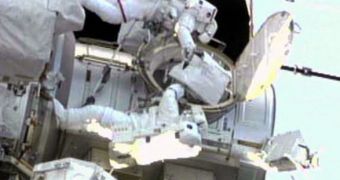Two astronauts from space shuttle Endeavour's STS-134 crew managed to complete the second extravehicular activity (EVA) planned for their 16-day stay at the International Space Station (ISS). The spacewalk didn't go flawlessly, but the crew members eventually completed all of their chores.
During the EVA, NASA astronauts Andrew Feustel and Mike Fincke were tasked with lubricating and greasing the rotary joint of the station's left-side solar array. Additionally, they also had to refill the ammonia tank powering a cooling loop.
The loop is slowly venting off the chemical, and so the tank has to be periodically refilled, until a more permanent solution can be devised. However, during this spacewalk, astronauts had some problems.
These mostly had to do with the fact that several bolts and washers started to pop free whenever the two were touching them. This caused a significant delay in the EVA schedule, Space reports.
When Feustel and Fincke exited the Quest Airlock, at 2:05 am EDT (0605 GMT) on Sunday, May 22, they were expecting to conclude their mission in about 6 hours and 30 minutes. The delays eventually saw them carrying on for 8 hours and 7 minutes.
They returned inside the ISS at 10:12 am EDT (1412 GMT). According to NASA statistics, this makes the EVA the sixth longest in the space agency's history. Regardless of length, the most important thing is that every task was completed, mission controllers say.
The third of four EVA planned for the STS-134 mission is scheduled to take place on Wednesday, May 25, the flight manifest shows. Endeavour will remain docked to the ISS until May 29. After spending the next day in orbit, it will land at the KSC on June 1.
This is the last flight that the shuttle will ever perform, and it's also one of the most important it ever flew. Stored aboard Endeavour during its trip to orbit was the Alpha Magnetic Spectrometer (AMS).
The $2 billion particle detector – which was already installed outside the ISS – is capable of measuring cosmic rays, and test for predictions related to the existence of dark matter and dark energy.
The AMS is the most complex scientific experiment ever flown in space, and also the last major contribution that the United States made to the International Space Station. The last shuttle flight, Atlantis' STS-135 mission – will only deliver space parts and supplies.

 14 DAY TRIAL //
14 DAY TRIAL //